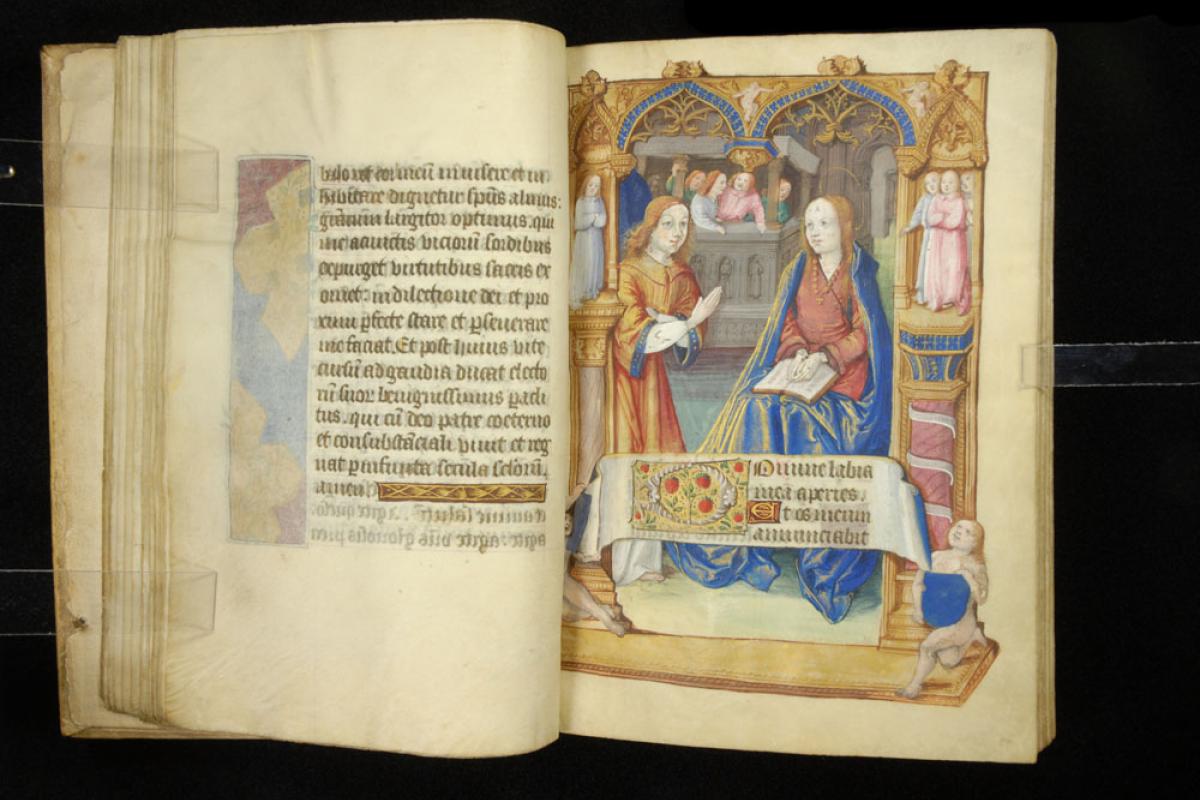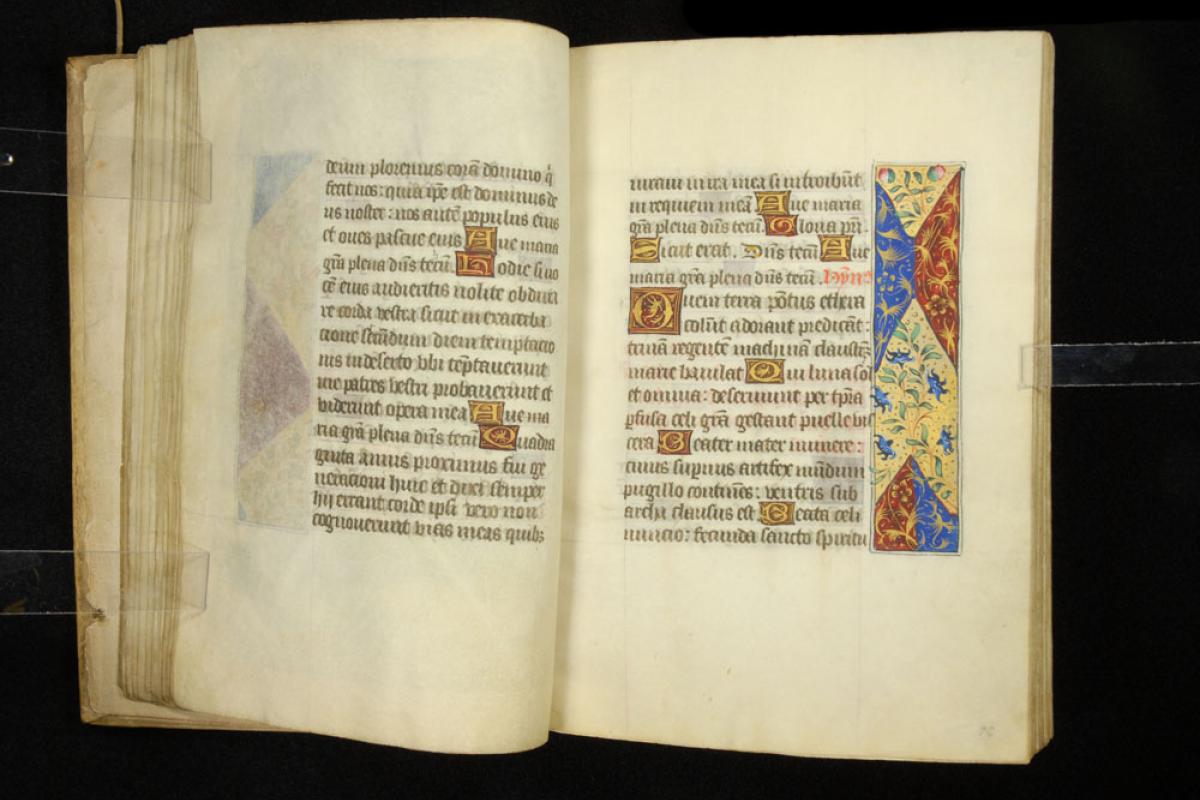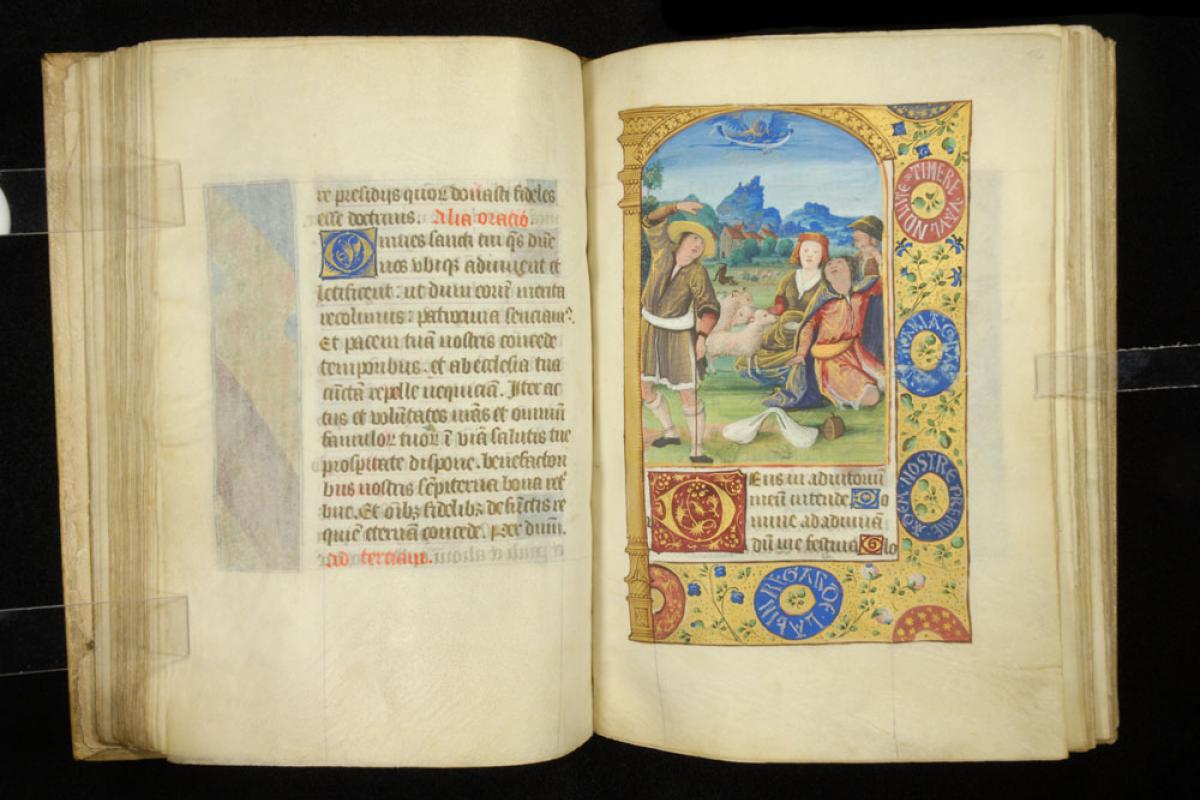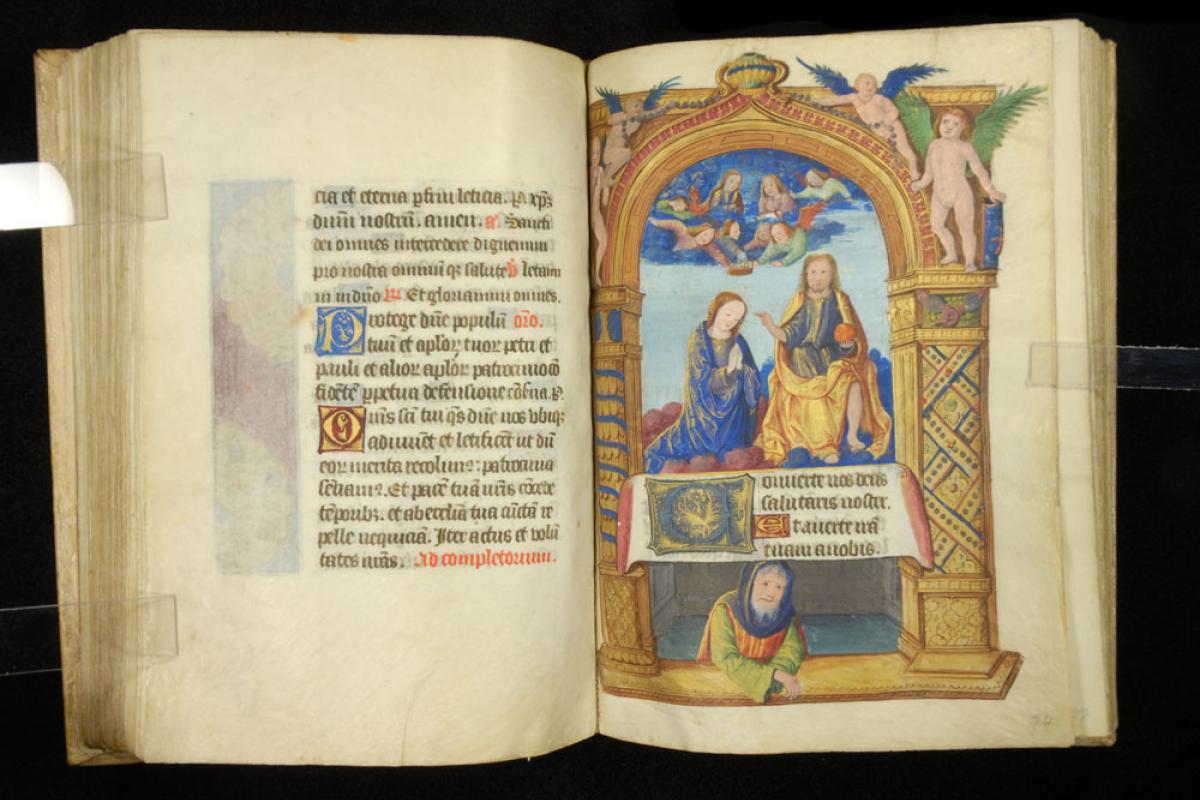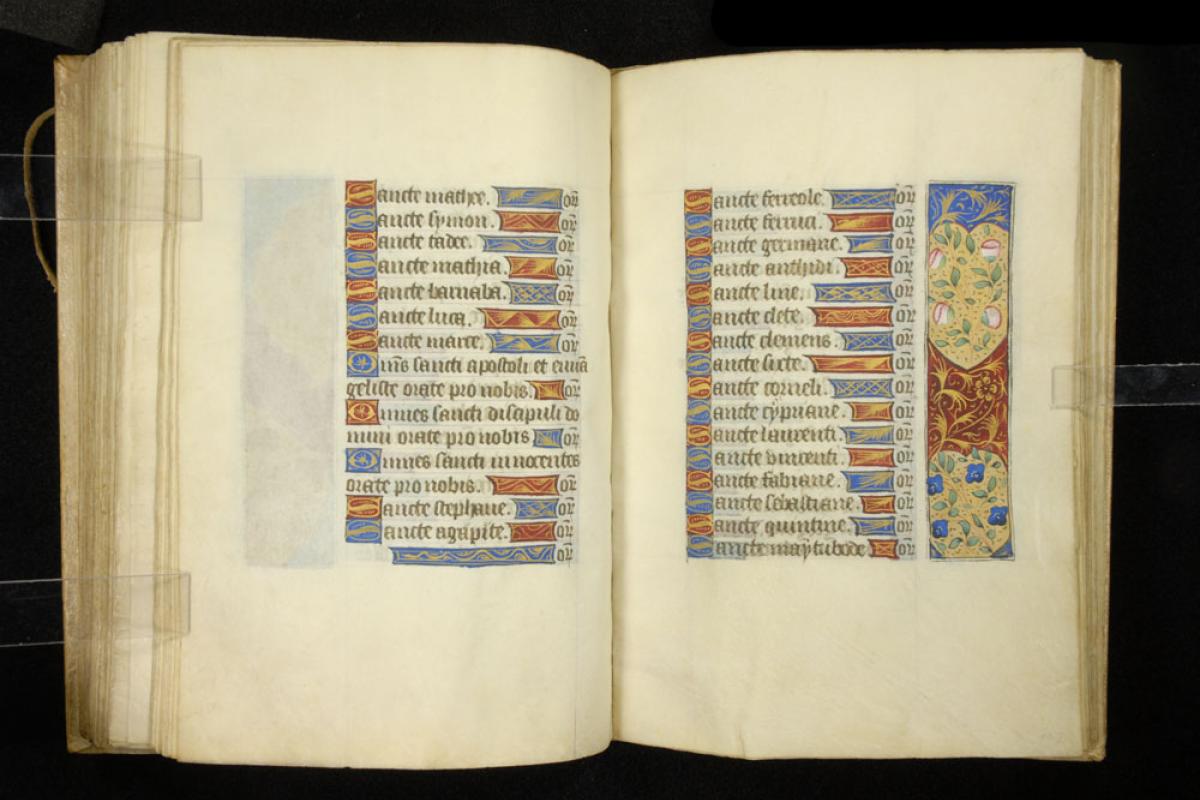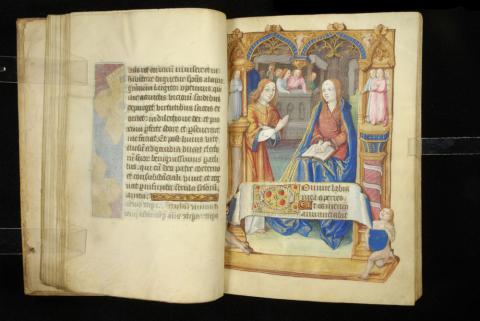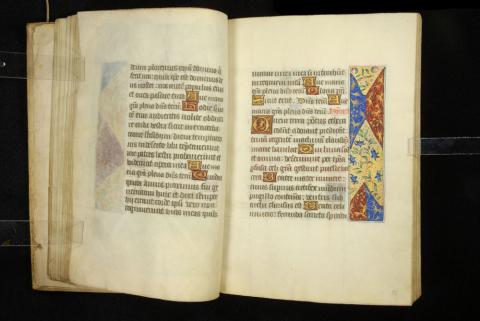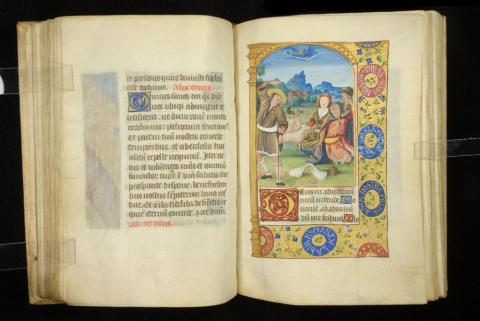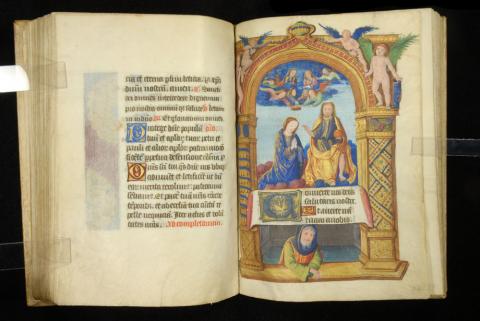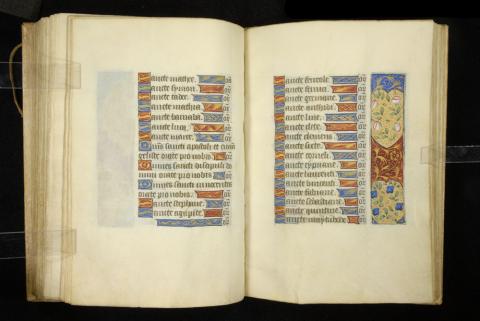Book of Hours, Use of Rome
Book of Hours, Use of Rome
French, ca. 1525
Images:
fols. 23v-24r: Annunciation (Hours of the Virgin, Matins)
fols. 25v-26r: Text pages from the Hours of the Virgin
fols. 55v-56r: Annunciation to the Shepherds (Hours of the Virgin, Terce)
fols. 73v-74r: Coronation of the Virgin (Hours of the Virgin, Compline)
fols. 106v-107r: Text pages from Penitential Psalms and Litany
Language: Latin with some French
vellum
height 22 cm
width 15.7 cm
162 leaves. Pointed Gothic script. 16 lines. Gatherings mostly of 8. Text in Latin and French. Calendar, Gospel Lessons, Obsecro te, O Intermerata, Hours of the Virgin, of the Passion, of the Holy Spirit, Psalms, Litany, Office of the Dead, Prayers to Saints and the Virgin, 15 Joys of the Virgin. 14 large and 9 small miniatures, signs of the zodiac and labors of the months in the calendar borders. Binding: vellum with gold tooling, tied with thongs.
Mount Angel Abbey Library, Ms 29
Jeff Brown, Medieval Portland Research Assistant
This book of hours is indicative of northern French workshops—reminiscent of assembly line production—after their heyday in the fifteenth century. Architectural elements, revealing an Italian Renaissance influence, frame several of the illuminations. Lackaff identifies the handiwork of as many as three separate artists in the miniatures, but otherwise, the prayerbook exhibits an overall sense of consistency and homogeneity. While there are no substantive clues to the identity of the original owner of this piece, a date of c. 1510 for its creation is reasonable, based on stylistic analysis and comparanda.
Diebold, William. The Illustrated Book in the Age of Printing: Books and Manuscripts from Oregon Collections. Portland, OR: Douglas F. Cooley Memorial Art Gallery, 1993, p. 12-13 - Quoted with permission
12. Book of Hours, Use of Rome
Northern or Central France, c. 1500
Mount Angel Abbey Library, MS 29
Fols. 92v-93r: Text Page; David penitent and David Killing Goliath
29. Book of Hours, Use of Langres
Paris, printed by Philippe Pigouchet for Simon Vostre, c.1502
Willamette University Library BX2080.P5 1502
Fols. e1v-e2r: Text pages
30. Leaf from a Book of Hours
probably Paris, probably printed by Philippe Pigouchet for Simon Vostre, early years of the 16th century
Mount Angel Abbey Library, MS [sic] 83
Fol. c1r: Text Page
Although the program of decoration in printed Books of Hours tended to follow traditions already established by manuscripts, the printed Books are remarkable for the number of illustrations they contain. Every page in number 29 [refers to exhibit from which this text was a catalog entry], for example, has fully illustrated borders. The reproductive nature of printing meant that, once wood blocks had-been cut and were owned by a printer or publisher, they could be used again and again with no additional cost. Thus, many of die same blocks are used in both numbers 29 and number 30, even though the actual text of the pages on display differs. No manuscript Book of Hours, no matter how sumptuous, had this wealth of decoration.
Printing raised the stakes of how densely a book could be illustrated; manuscript makers tried hard to respond. Number 12, a manuscript contemporary with these printed Books of Hours, has an exceptionally lavish program of illustrations, even though there is no sign that it was made for a particularly elevated patron. Rather, the large number of miniatures is probably an attempt to compete with the proliferation of images brought about by printing. In the page on display the unusual two-tier format, with the scene of David killing Goliath in the lower register, may have been inspired by the small scenes which fill the margins of printed books of hours such as numbers 29 and 30.
Parshall, Peter. Illuminated Manuscripts from Portland Area Collections. Portland, OR: Portland Art Museum, 1978, p. 44 - Quoted with permission
Illusionistic architectural devices set a stage-like space for the miniatures. Figures obtrude from the frames, and putti careen from the arched procenia. Panels of text unfurl across the picture space like banners. The figure style is a synthesis of Flemish traditions sensitively absorbed by French artists such as the Master of Moulins, and an overly precious interpenetration of Italian sources characteristic of artists such as Jean Bourdichon. The architectural borders are likewise a reflection of Italian decoration and book design. Tastes in the French court was increasingly shaped by Italian art over this period and the following decades. Although often condemned for its eclectic tendencies, the final phase of French book illumination often shows renewed energy and and surprising ambition in the face of decline. Monumental compositions from religious painting and even portraiture are readily included in more luxurious books of the period. The proliferation of subjects and full-page miniatures indicates an increasing regard for the hand-made book as an aesthetic object at a time when texts could be printed for much more cheaply for those who desired them. The style of this book suggests that it has been localized in Rouen.

